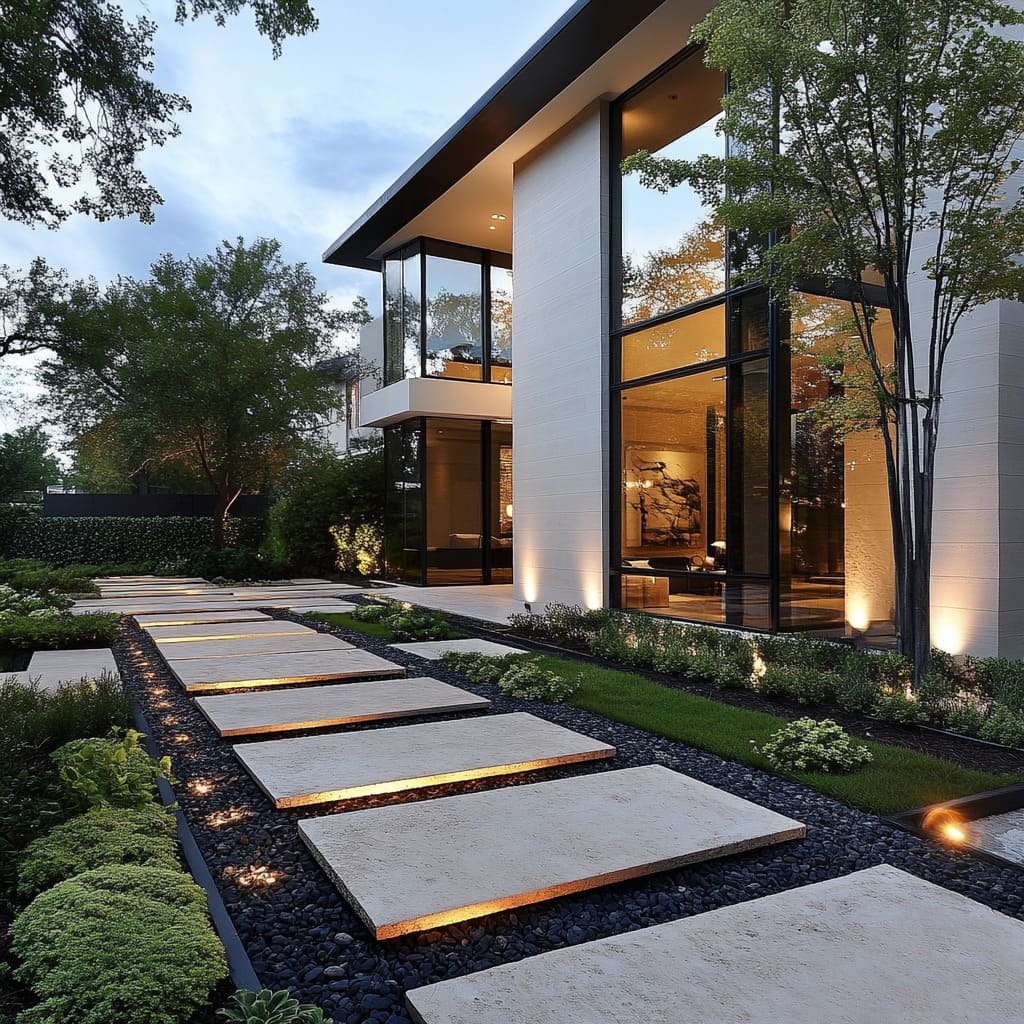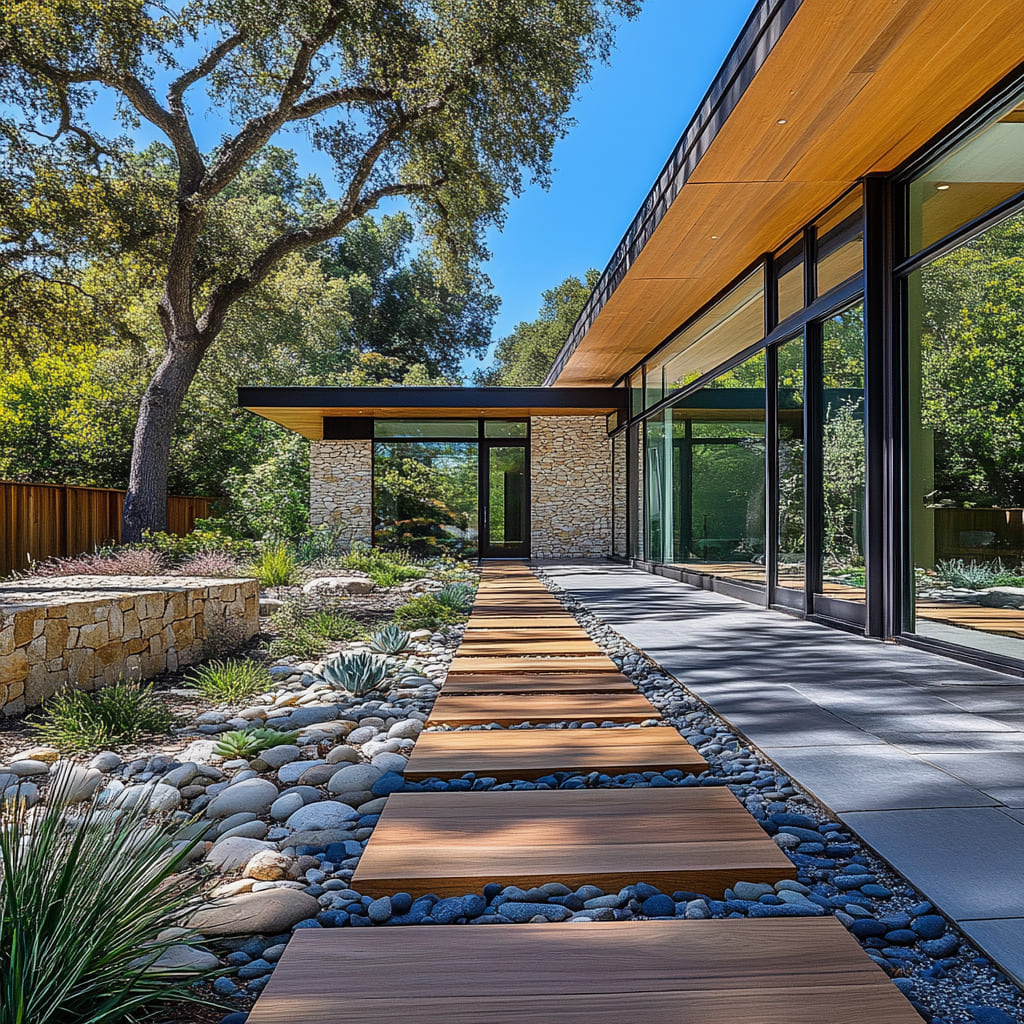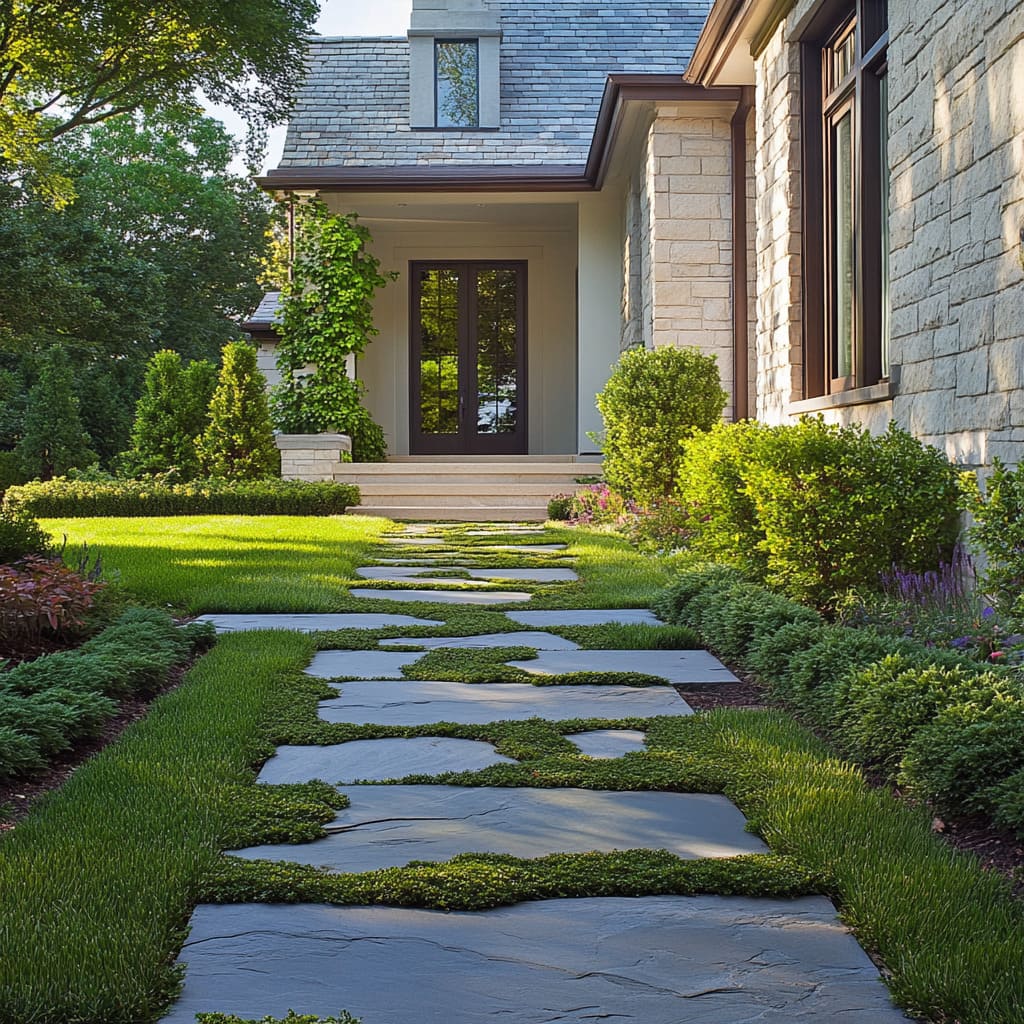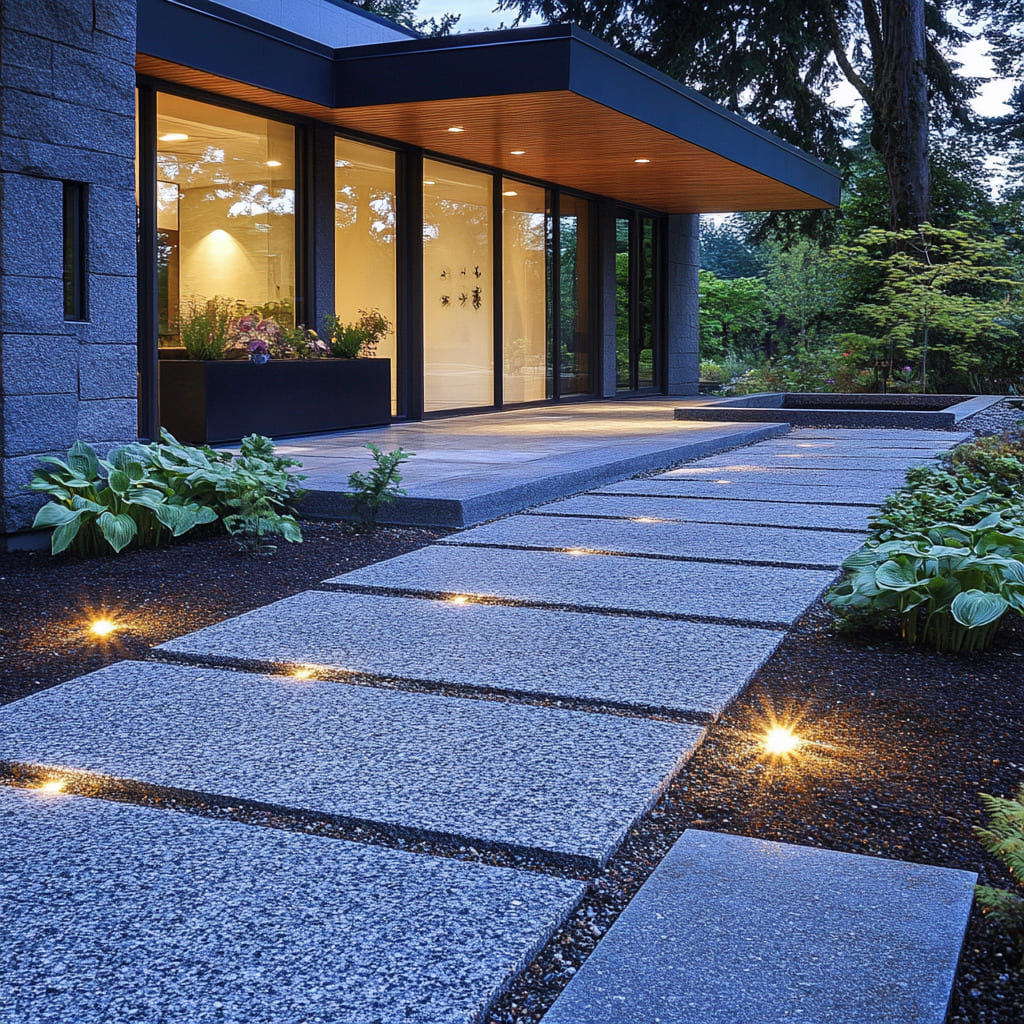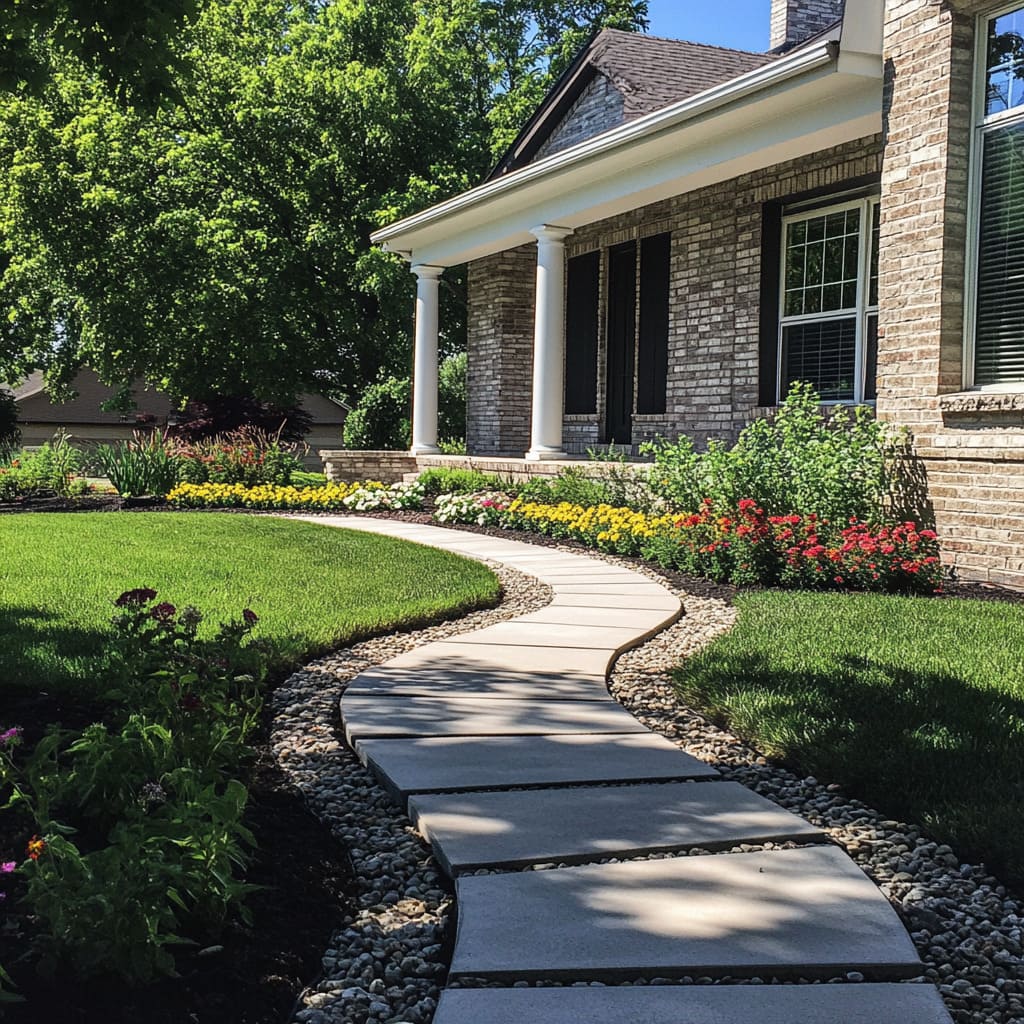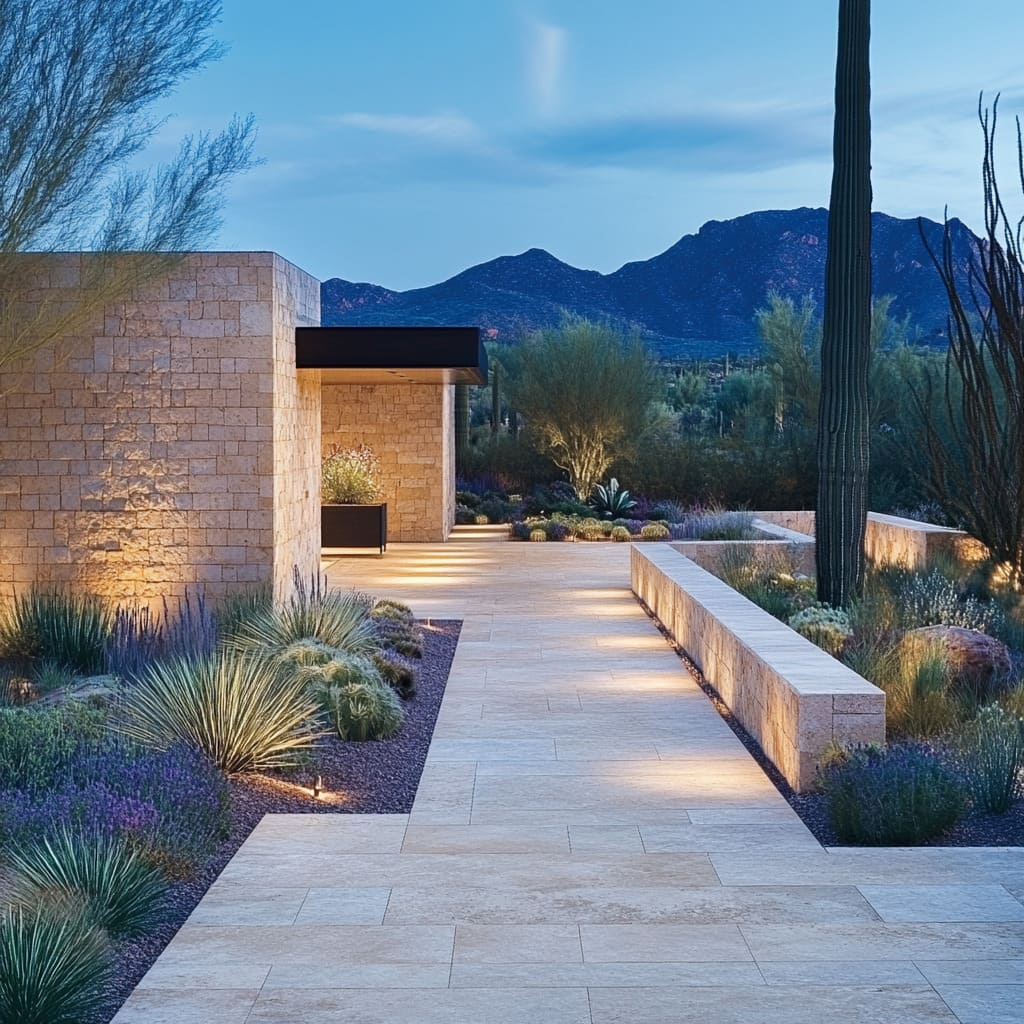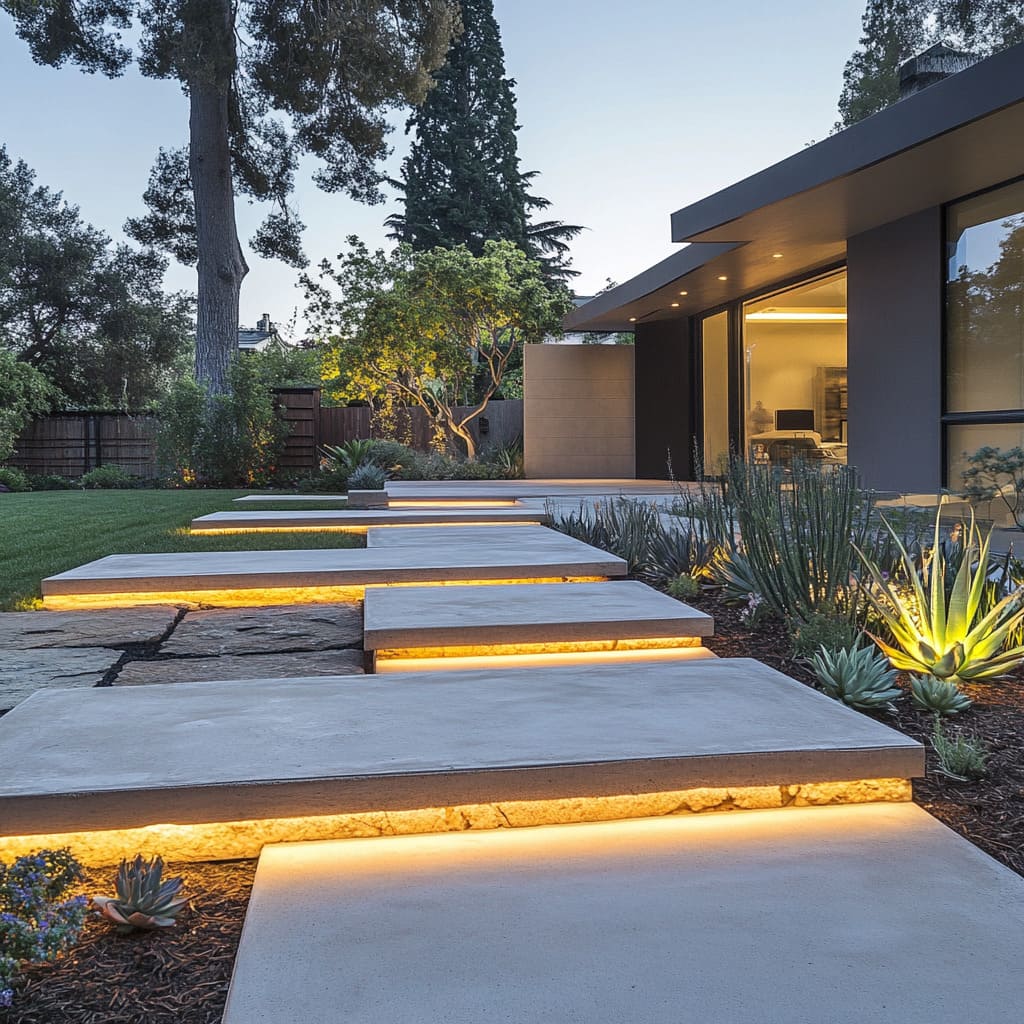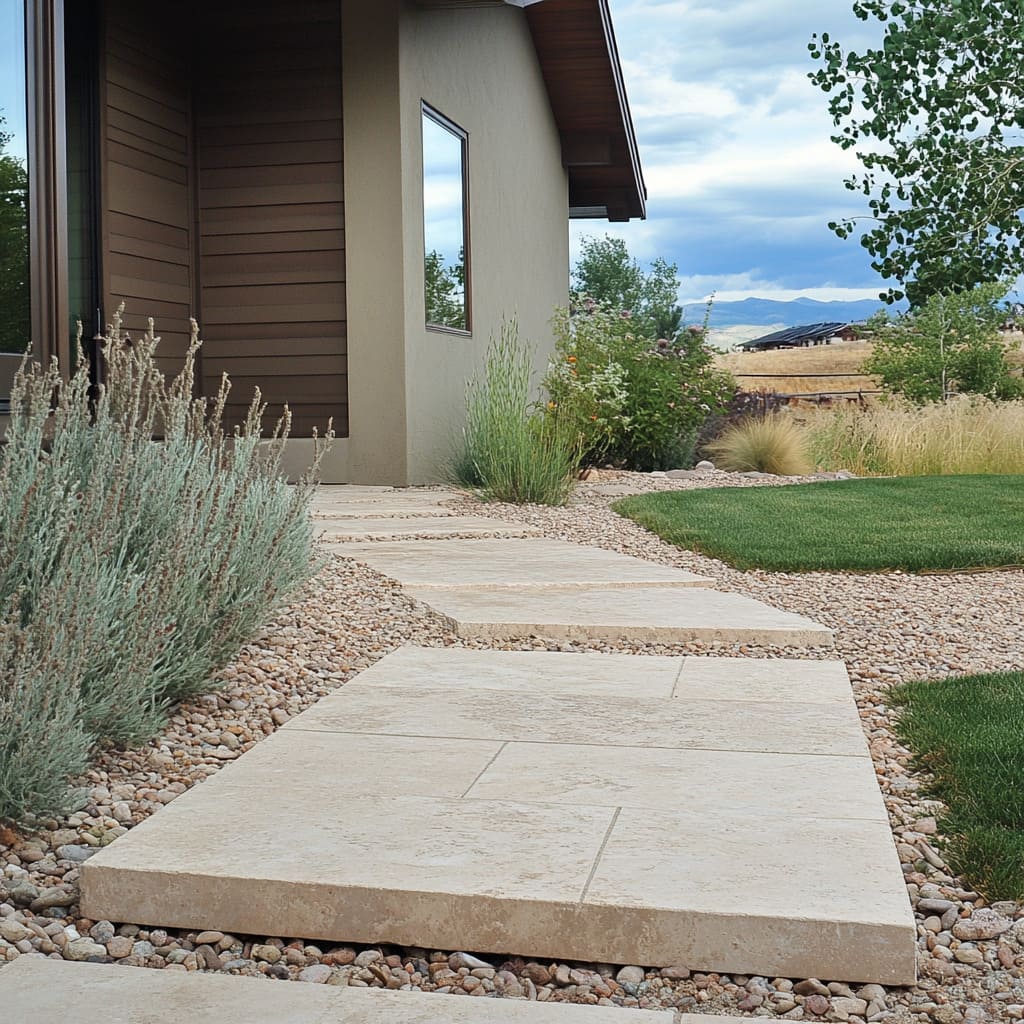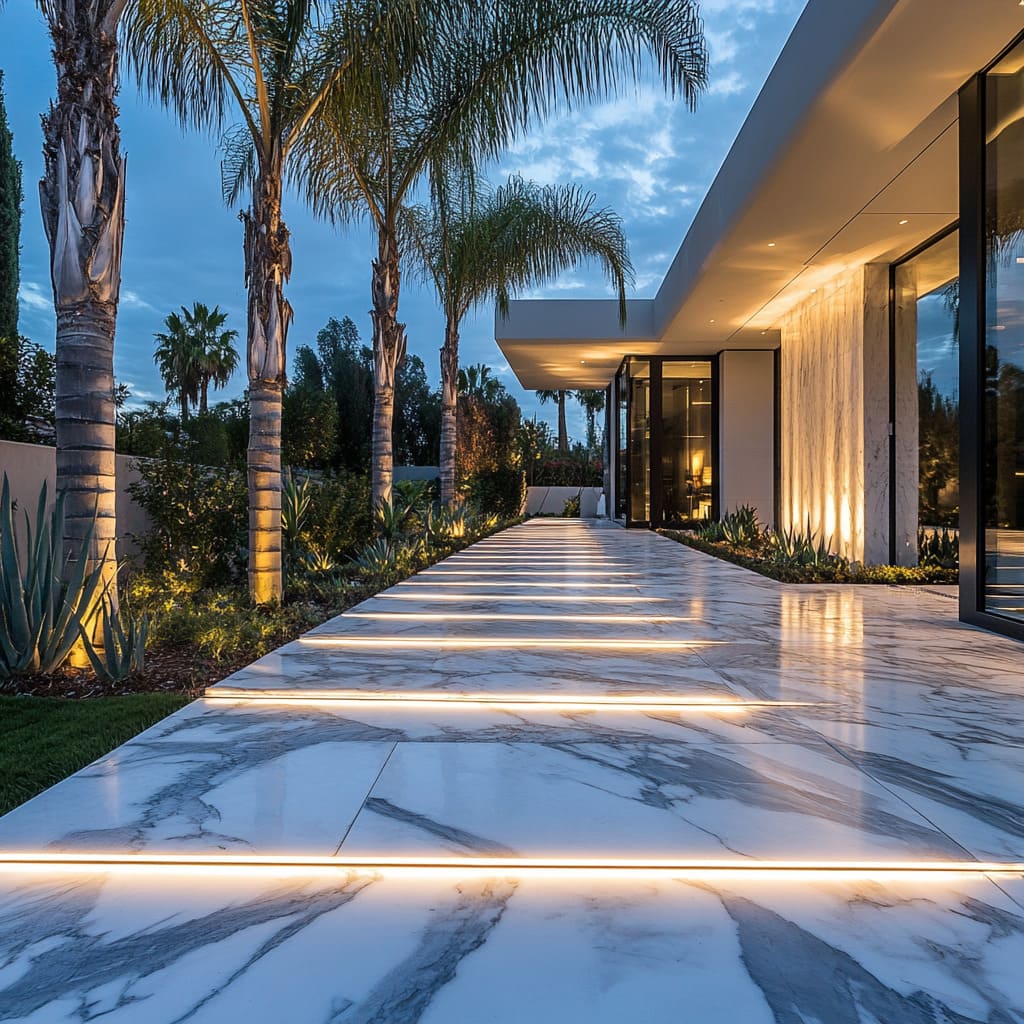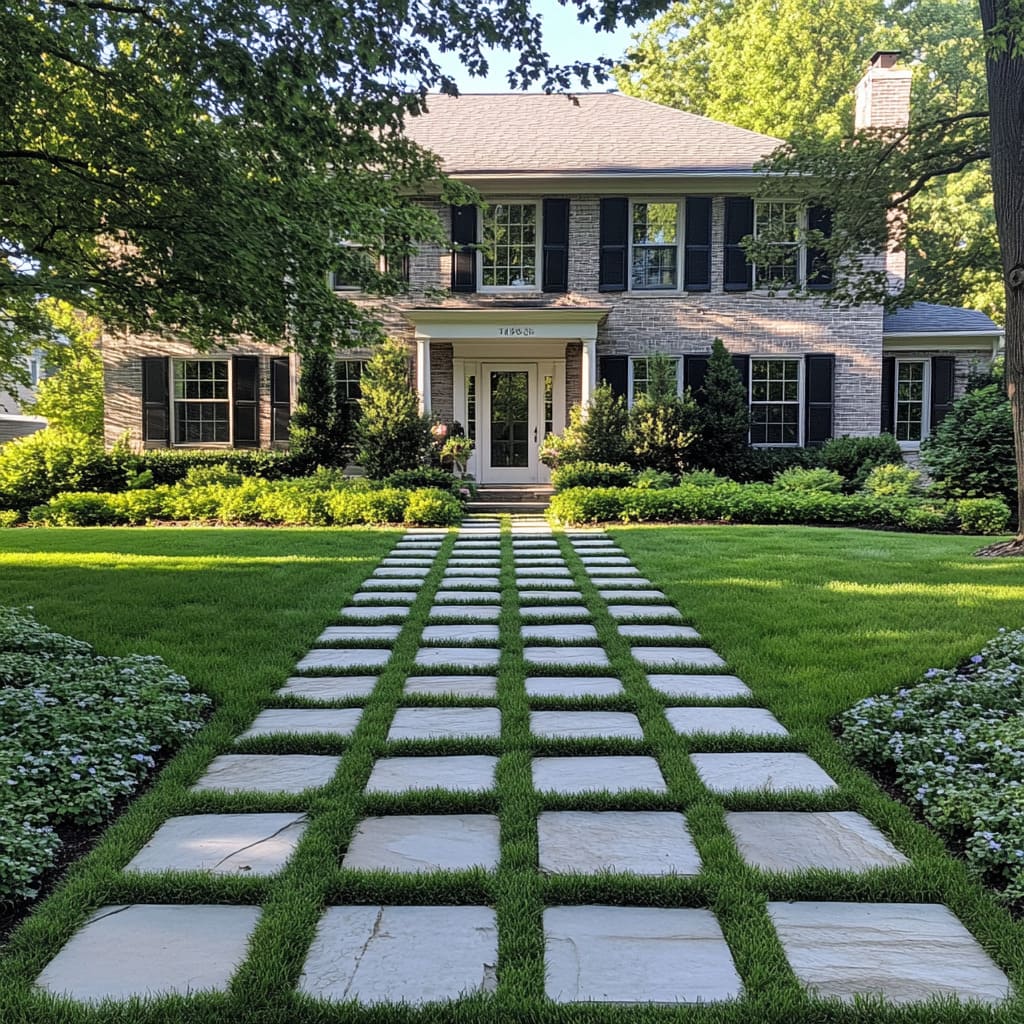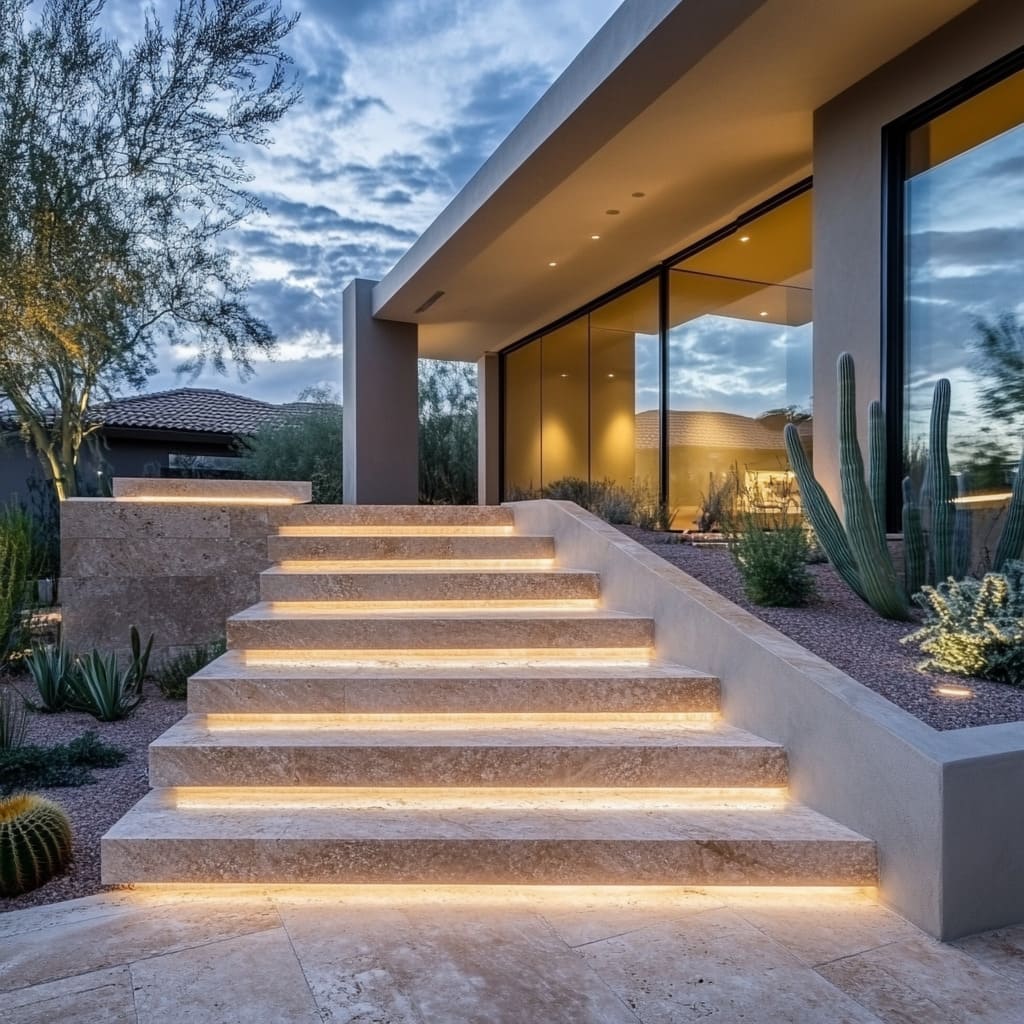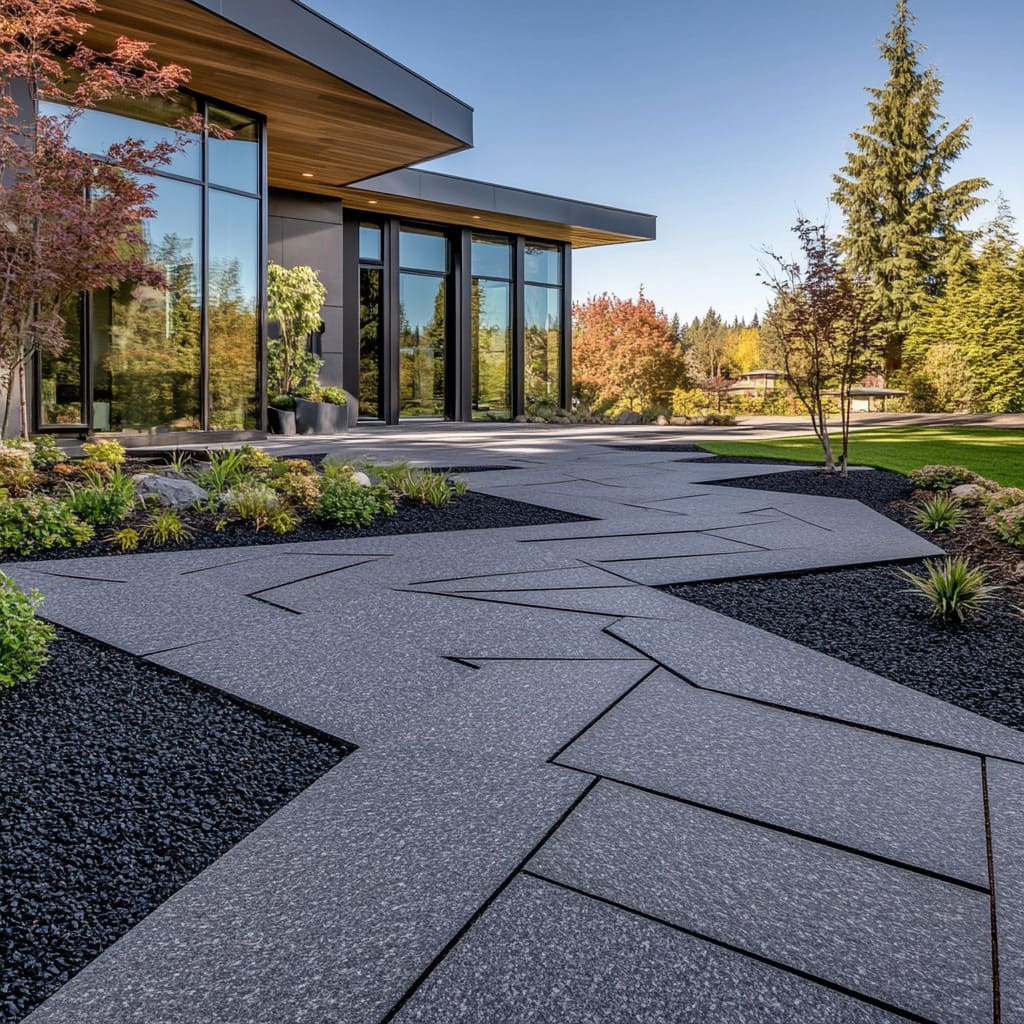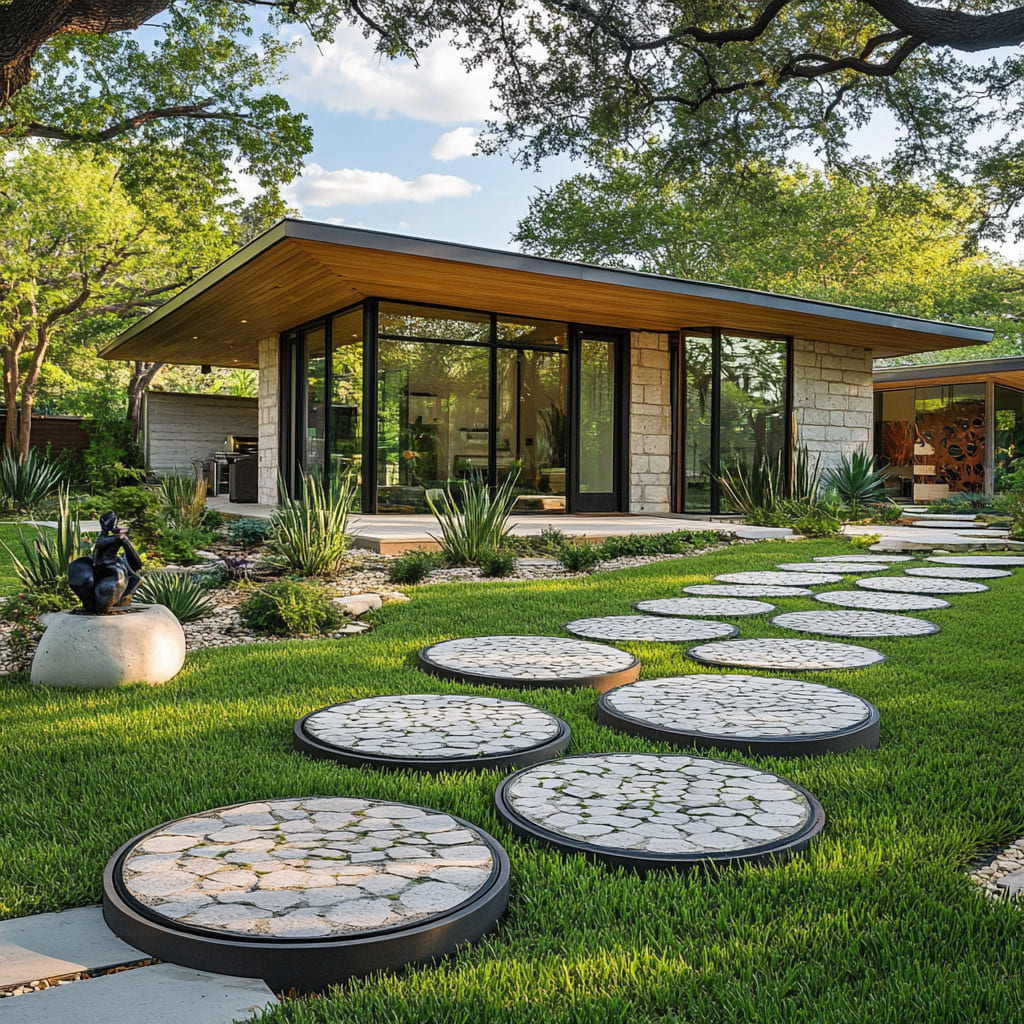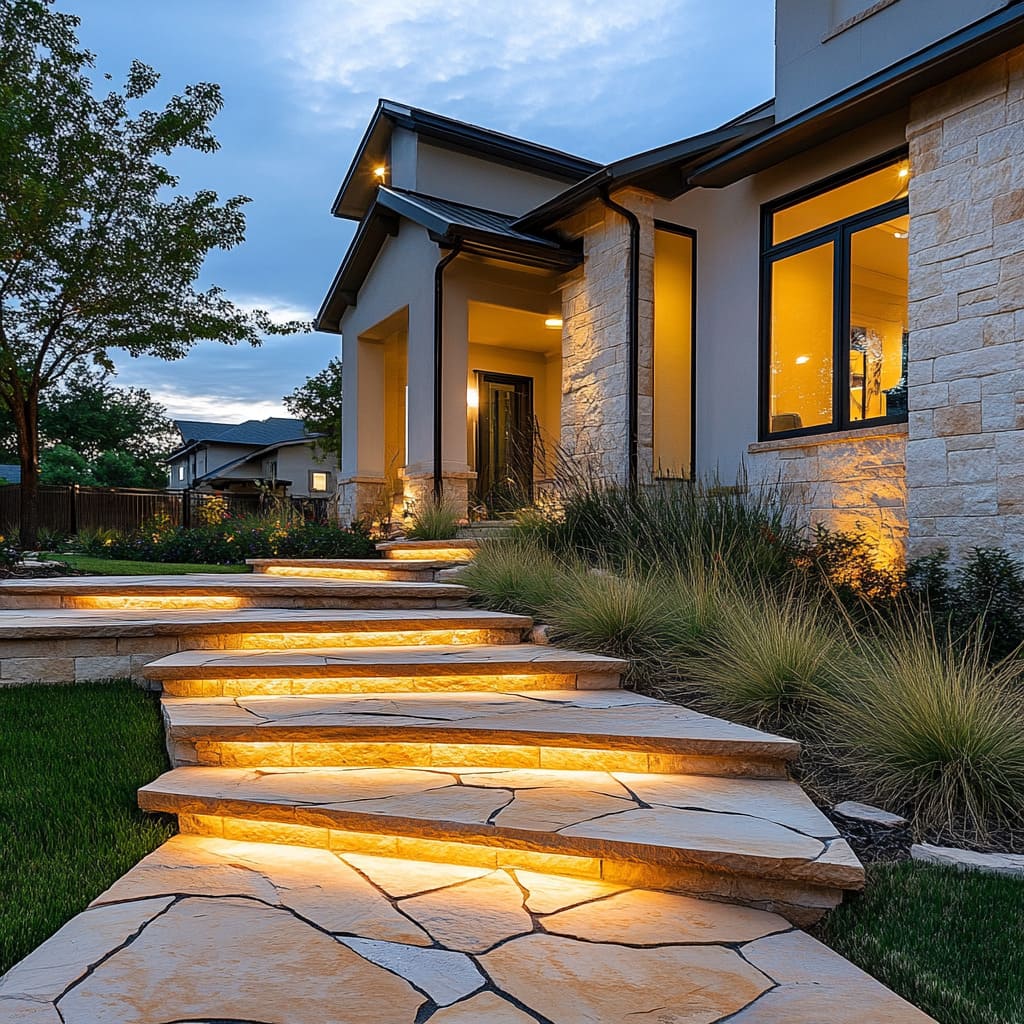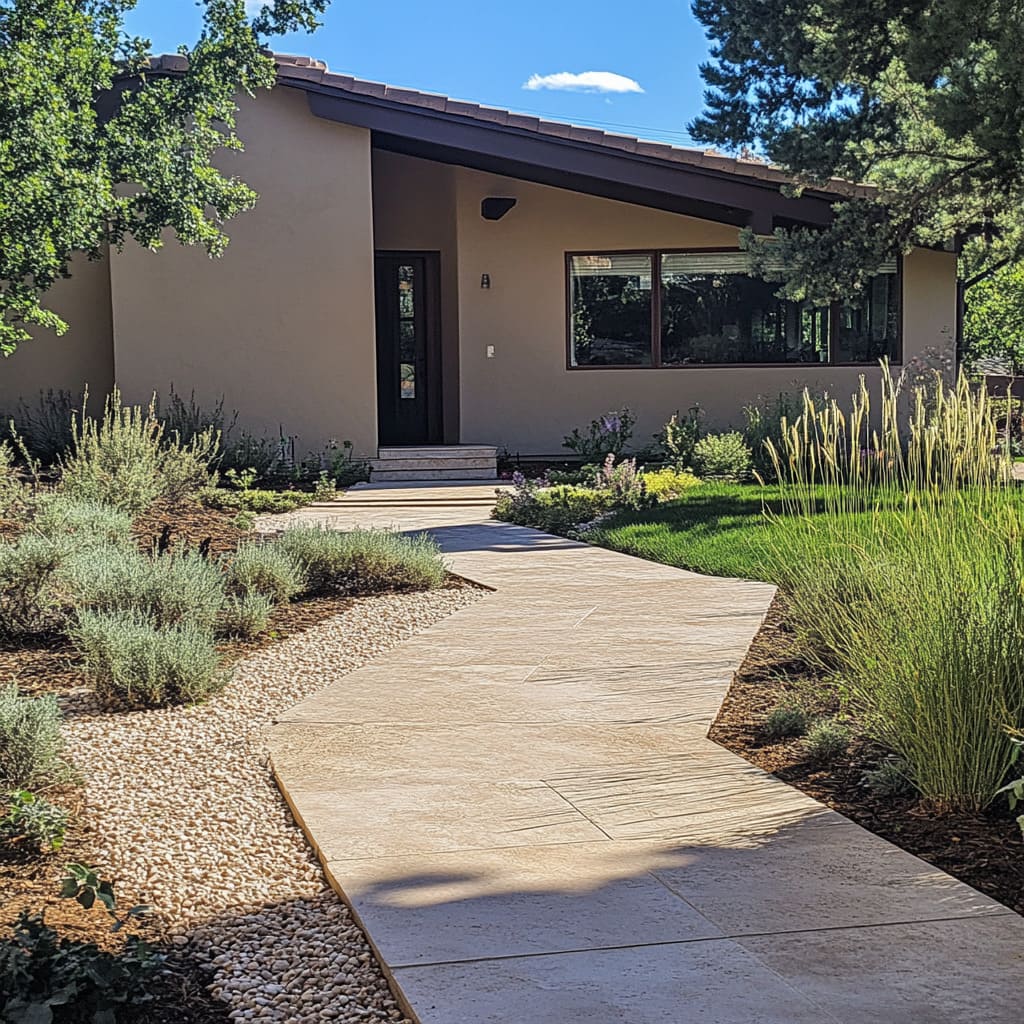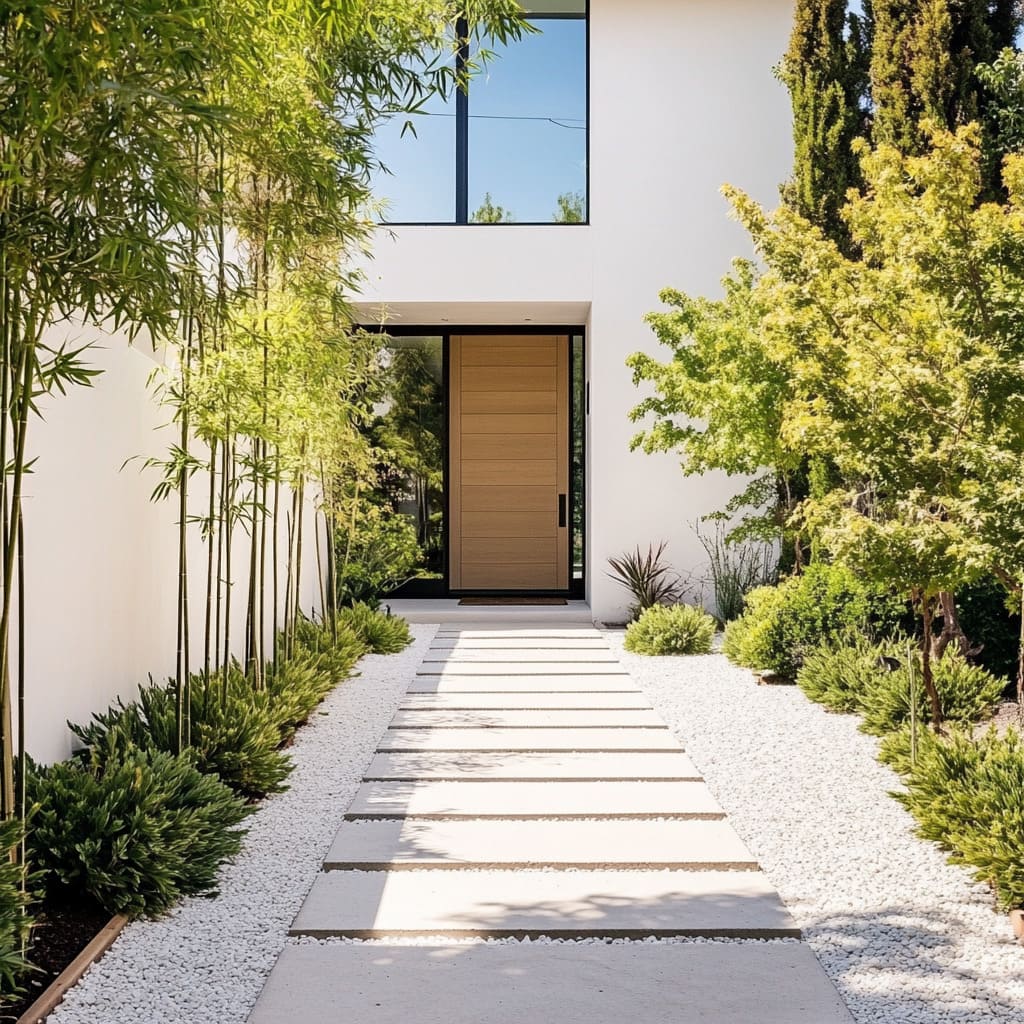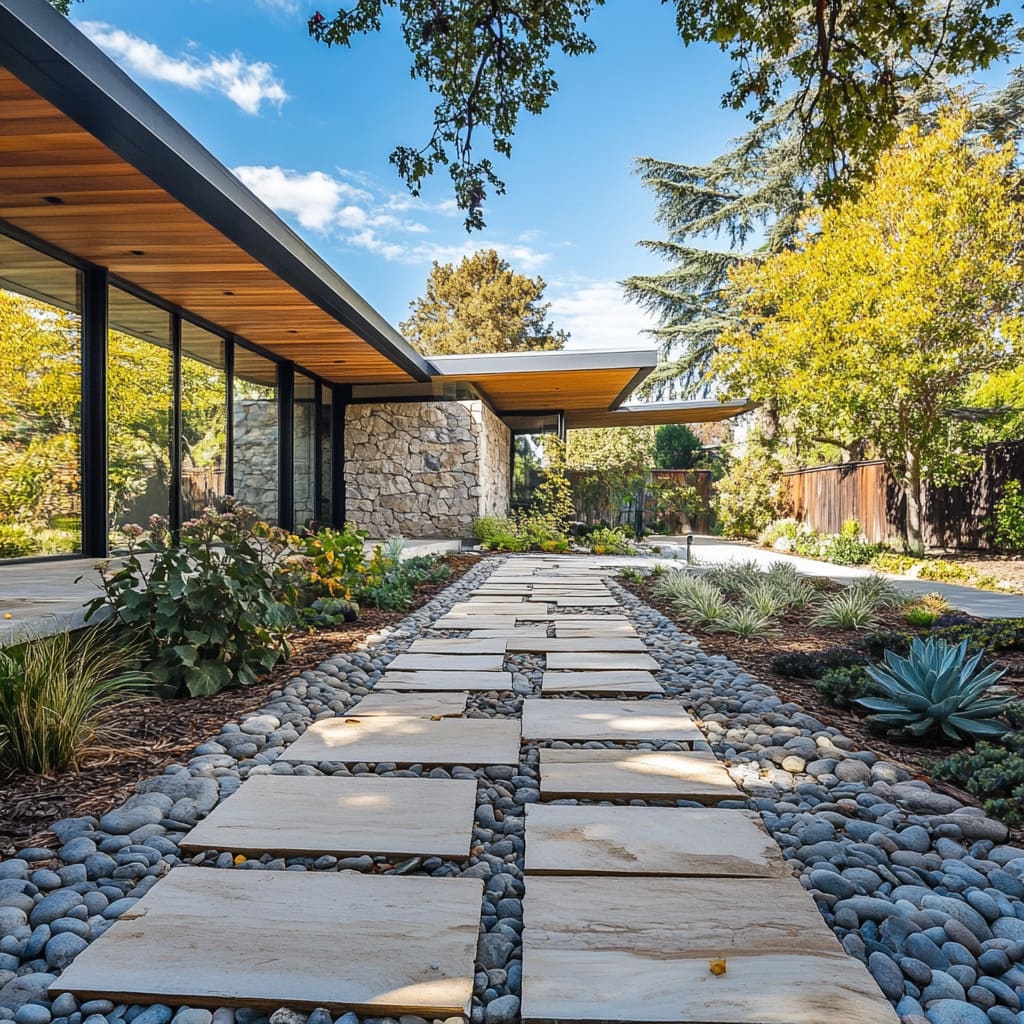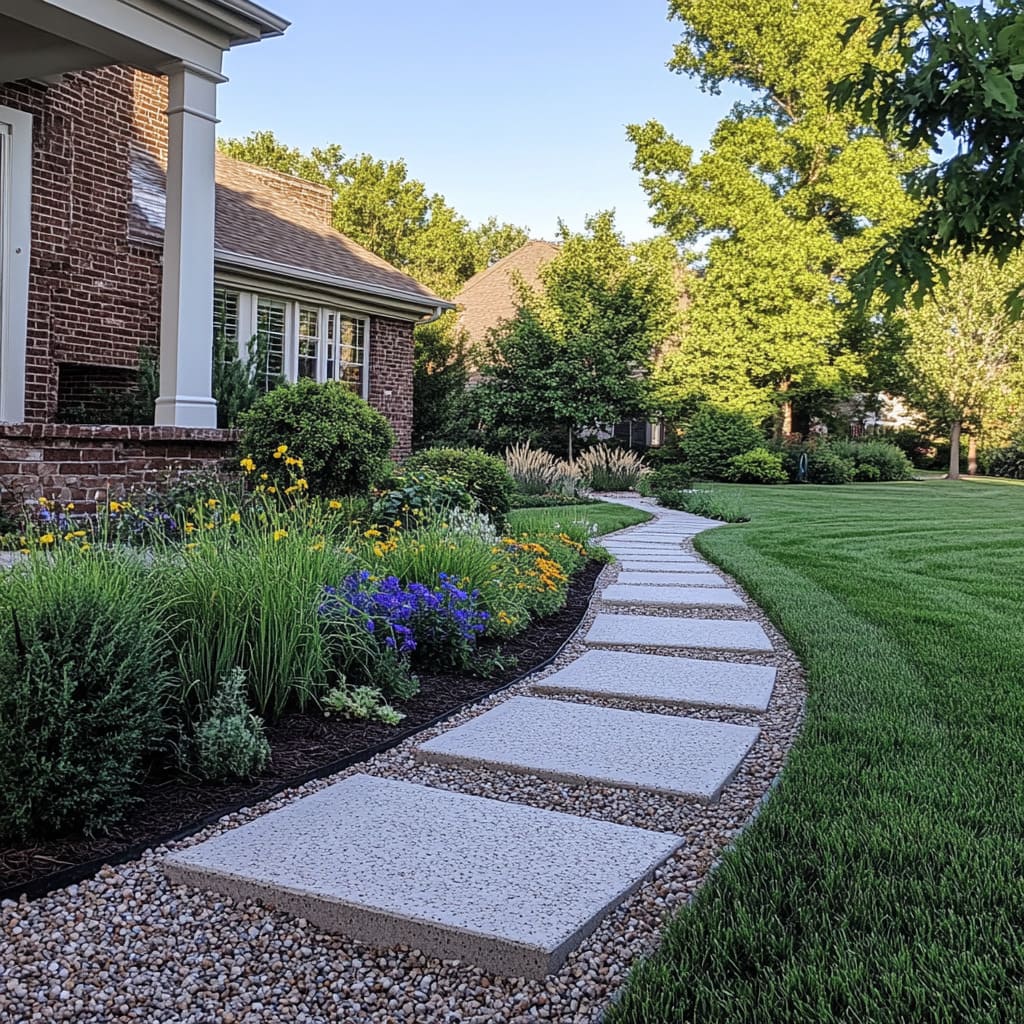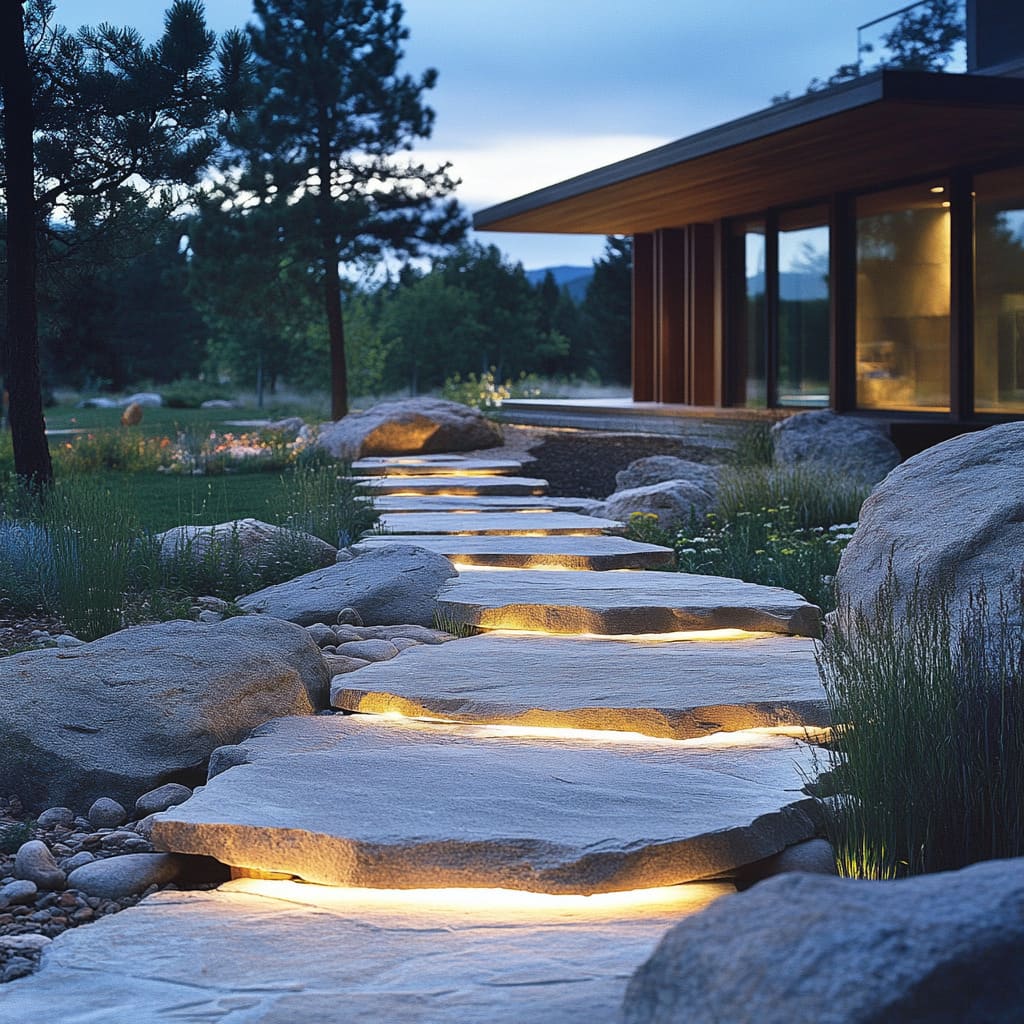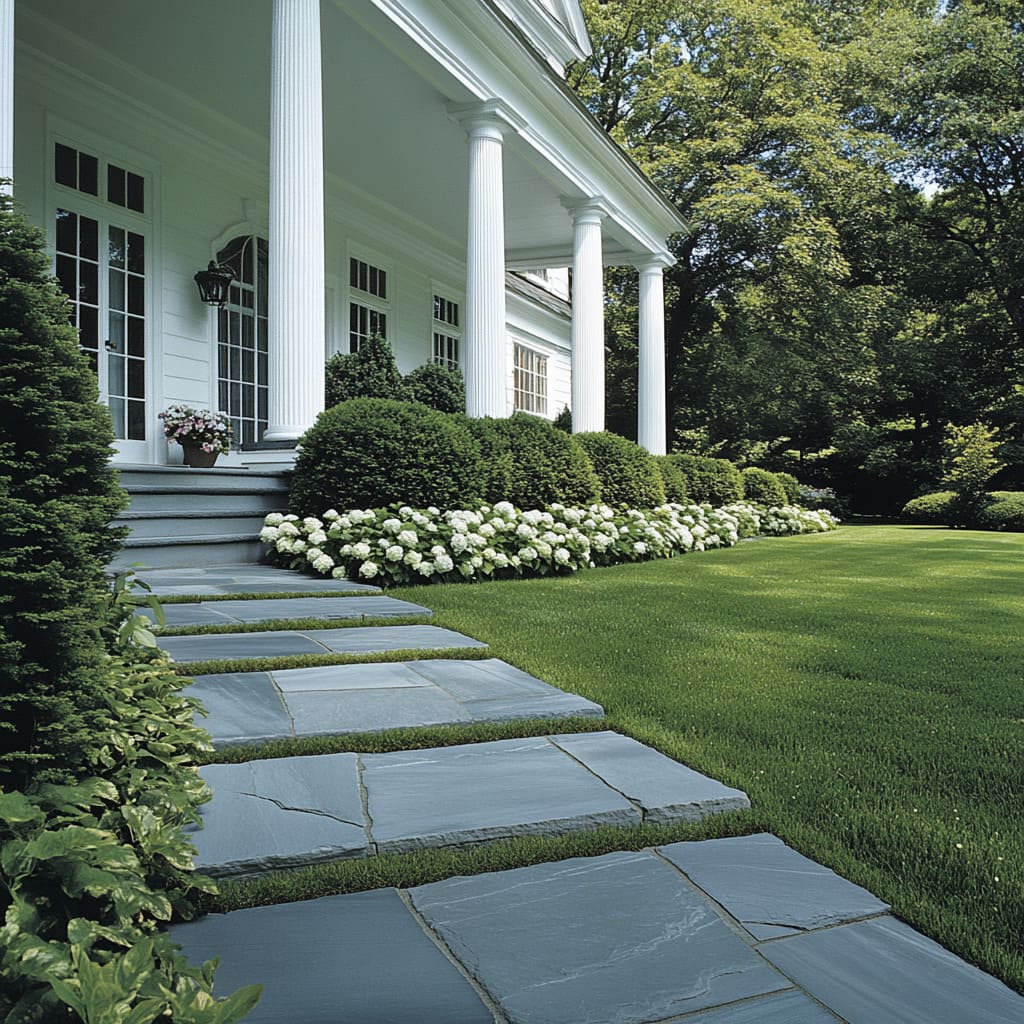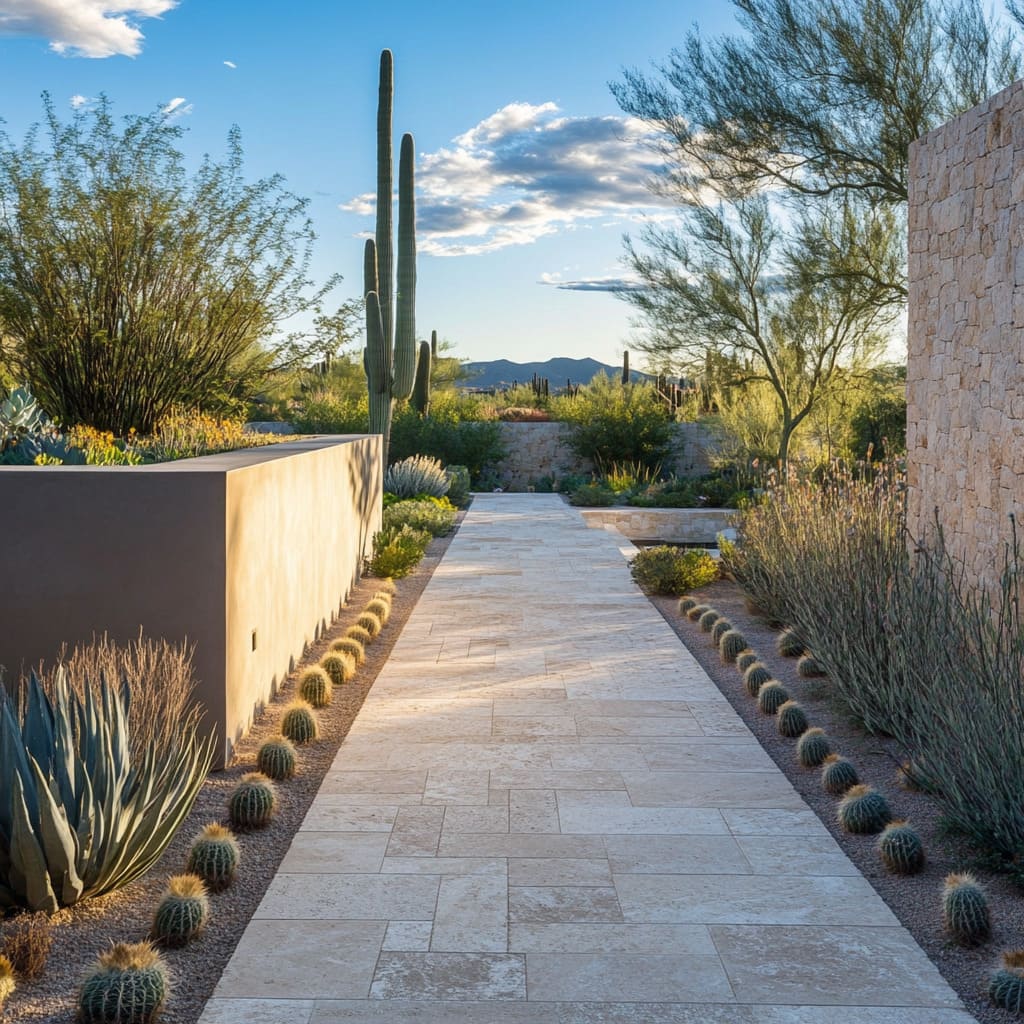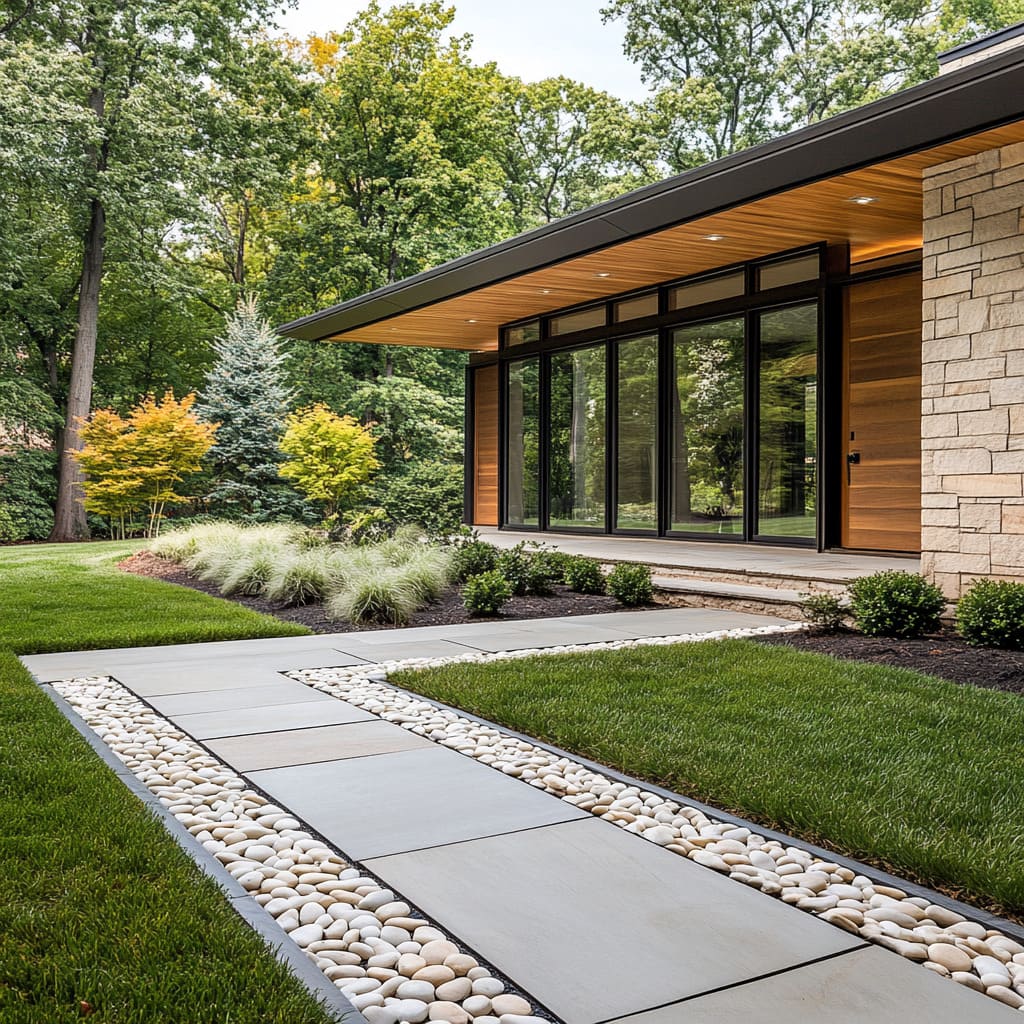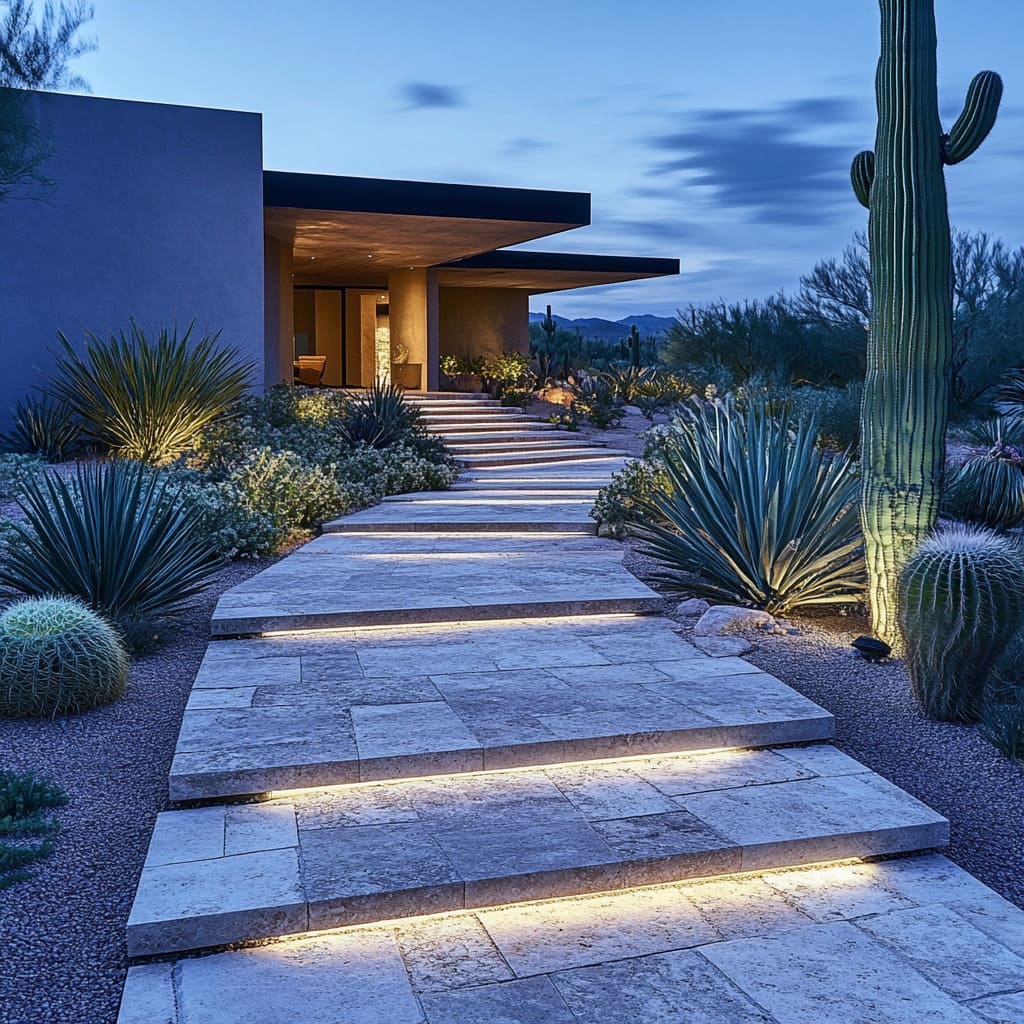Stone pathways have long been essential elements in garden design, providing both structure and flow. Whether leading guests through a sprawling yard or creating a meandering trail in a cozy garden, pathways define the layout and enhance the visual experience of outdoor spaces.
In recent years, the trend toward modern stone pathways has gained popularity, combining clean lines, innovative materials, and creative layouts. These pathways go beyond mere functionality, transforming gardens into artful spaces.
From geometric patterns to carefully curated materials, modern pathways bring out the potential of any landscape design, balancing beauty and practicality.
Beyond their basic purpose, stone pathways offer an avenue for creative expression. They allow homeowners to define their space with materials that blend into the landscape or stand out as a feature of the garden.
Whether you’re looking for inexpensive stepping stone walkway ideas or something more luxurious, there’s a wide variety of stone pathway ideas to suit different styles, budgets, and garden themes. By thoughtfully selecting the right materials and incorporating unique design elements, a stone path can become more than just a practical route—it can elevate the overall ambiance of the outdoor area.
Selecting the Right Stone Material
Granite for Durability and Elegance
Granite has become a top choice for those seeking durable and stylish options for garden pathways. This natural stone is known for its strength, capable of withstanding weather conditions without losing its refined appearance.
Granite’s resistance to wear and tear makes it particularly suitable for areas with heavy foot traffic or changing weather, ensuring a long-lasting investment. For a modern aesthetic, granite is perfect for creating sleek, minimalist paths.
It complements contemporary home designs with its smooth surface and subtle color variations.
In particular, a zigzag granite pathway, as seen in certain modern gardens, brings an unexpected twist to traditional layouts. The geometric arrangement of granite pavers adds movement and visual interest to the space, transforming a straightforward pathway into a statement piece.
Granite’s neutral tones—from light greys to deeper charcoals—also allow it to blend effortlessly with various garden styles. Whether paired with minimalist landscaping or more traditional greenery, granite pathways provide a sense of cohesion between the garden and the architecture of the home.
Travertine for a Warm and Luxurious Look
Travertine is another popular material for those aiming to introduce a sense of luxury to their garden design. Known for its warm tones and slightly textured surface, travertine offers a more natural look compared to the sleekness of granite.
The stone’s soft beige hues work well in both formal and relaxed settings, bringing warmth and sophistication to any garden space.
A stepping stone walkway idea using travertine creates a beautiful balance between formality and a laid-back feel. The uneven texture of the stone makes each step feel grounded, while its neutral color palette ensures it remains versatile enough to complement a wide range of landscapes.
This material is particularly effective in gardens with Mediterranean-inspired designs or those featuring natural elements like water features and lush greenery. In addition to its aesthetic appeal, travertine’s slightly porous surface provides excellent traction, making it practical for outdoor pathways in areas that experience rain or moisture.
Travertine walkways can also help create visual continuity, especially when extended from outdoor patios or pool areas.
Creative Pathway Layout Ideas
Zigzag Patterns for Visual Impact
One of the most striking ways to design a modern stone pathway is through the use of zigzag patterns. This unconventional layout breathes life into what might otherwise be a straightforward garden path.
By introducing sharp angles and dynamic movement, zigzag paver designs break the monotony often seen in straight paths. The geometric forms create visual intrigue, drawing the eye and adding a modern twist to the landscape.
Zigzag patterns aren’t just about aesthetics; they influence how people interact with the space. This layout encourages a sense of exploration, making the simple act of walking through the garden a more engaging experience.
Curved and Organic Pathways for Natural Flow
For a softer approach, curved or gently meandering pathways are ideal, especially in gardens with a natural or more relaxed feel. Unlike the sharp angles of zigzag paths, curved pathways flow organically, creating a sense of ease.
This design helps soften the hard lines of nearby architecture, making the space feel more integrated with nature. Curved paths are perfect for leading visitors on a gentle journey through the landscape, encouraging them to slow down and take in their surroundings.
This organic flow works particularly well with stone sidewalk ideas that involve the use of materials like pebbles or uneven stone slabs.
Integrating Lighting for Functional Beauty
Recessed Lighting Underneath Pavers
Lighting is an often-overlooked element in garden design, but when done right, it can transform a space. One of the most effective and stylish ways to integrate lighting into a stone pathway is by installing recessed lighting beneath the pavers.
This subtle yet impactful lighting solution creates a dramatic floating effect, where the pavers seem to hover just above the ground at night. This design is particularly effective with stone pathways that feature multi-level walkways or steps.
The soft glow emitted from the recessed lights not only highlights the texture and beauty of the stone but also provides safety by illuminating each step. Whether using materials like travertine, granite, or natural stone walkway ideas, recessed lighting adds a touch of elegance while ensuring the path is functional after dark.
Beyond aesthetics, recessed lighting is practical, as it offers gentle illumination without overpowering the garden with harsh, direct light. The lighting can be timed to turn on at dusk, adding a magical element to evening walks while keeping energy consumption low.
Key Point: Recessed lighting beneath pavers adds ambiance and safety, while the floating effect creates a modern, visually appealing design element.
Uplighting Around Pathways
Uplighting around pathways is another clever way to highlight both the walkway and the surrounding landscaping. By strategically placing small lights at ground level, designers can emphasize plants, sculptures, or other features while casting a gentle glow on the path itself.
Uplighting is particularly effective for creating a balance between light and shadow, allowing the natural textures of stone and plants to be revealed in the evening. For example, placing uplights at the base of taller grasses or small trees creates an interplay of shadows that adds depth and drama to the garden.
This method is especially striking in minimalist gardens, where the careful placement of lighting enhances the beauty of simplicity.
Additionally, uplighting works wonders when combined with stone pathways that include variations in height or level. A gently curved path illuminated with uplights can guide visitors while also adding a serene ambiance.
Key Point: Uplighting around stone pathways adds depth and dimension to the garden design, creating a harmonious balance between light and shadow that enhances the natural beauty of the surroundings.
Balancing Hardscapes with Landscaping
Using Black Gravel and Natural Rock to Complement Stone Pavers
When designing modern stone pathways, the balance between hardscape elements and natural landscaping is crucial to achieving a cohesive look. One of the most effective ways to complement stone pavers is by combining them with black gravel or volcanic rock.
These materials add texture and contrast to the design, while also creating a smooth transition between the pathway and the surrounding environment. Black gravel, for example, adds depth and a bold visual element that enhances the sleekness of stone pavers.
The contrast between the dark gravel and the lighter stone creates a striking visual effect. Volcanic rock, with its rugged texture, offers a more organic, natural look.
In minimalist landscapes, this combination works beautifully, keeping the design clean while introducing layers of texture.
This approach is particularly effective in modern garden settings where the goal is to maintain a balance between simplicity and sophistication. Key Point: Gravel and rock soften the transition between the hardscape and the surrounding natural elements, contributing to a seamless, cohesive design in modern landscaping.
Incorporating Native and Drought-Tolerant Plants
A well-balanced stone pathway design doesn’t stop at the hardscape. The surrounding landscaping plays an equally important role in enhancing the overall aesthetic.
Incorporating native and drought-tolerant plants is a smart choice for modern gardens, especially in regions prone to dry climates or water restrictions. These plants require less maintenance and water, making them ideal for complementing stone pathways without overwhelming the design.
Ornamental grasses, for example, are excellent for adding texture and movement without overpowering the space. Their fine blades contrast with the solid, heavy look of stone pavers, adding a delicate, natural element that softens the hardscape.
Succulents are another great choice. With their sculptural shapes and low water requirements, they not only thrive in dry climates but also add visual interest with their unique forms and colors.
By choosing plants that match the climate and natural environment, you create a sustainable garden that enhances the walkway designs with stones. Key Point: Well-chosen plants, such as grasses and succulents, accentuate the pathway and harmonize with the modern design, providing a soft, natural touch that complements the stone’s structured look.
Architectural Integration with Pathway Design
Connecting Pathways to Contemporary Architecture
Modern stone pathways are more than just practical features; they can serve as extensions of the home’s architectural design. When creating a stone pathway, it’s essential to consider how the materials and layout will complement the style of the house.
For contemporary homes, sleek stone paths with clean lines often reflect the structured nature of the building itself, creating a seamless connection between the outdoor landscape and the home’s facade.
For instance, a slate walkway idea can beautifully echo the dark tones and crisp lines of modern architecture. The cool, natural texture of slate adds an organic yet sophisticated element to the pathway, mirroring the minimalist and sleek feel of the house.
It’s about creating continuity—where the architectural design of the house flows effortlessly into the landscape, making the entire space feel integrated.
Additionally, stone pathways can be used to direct the eye toward architectural focal points, such as large windows or a striking entrance. The right pathway can enhance the geometry of the home, drawing attention to its best features.
Key Point: The design of the pathway should enhance and reflect the architecture of the home, creating a seamless transition between indoor and outdoor spaces.
Maximizing Glass and Window Views of the Pathway
A well-designed stone pathway doesn’t just look good when you’re walking on it—it can also enhance the view from inside the home. Large windows that frame the garden create an opportunity to showcase the beauty of the pathway from the interior, turning the outdoor space into a living, changing artwork.
This is especially true in modern homes with open layouts and expansive glass panels. When designing your pathway, consider how it will look from different angles within the house.
Pathways with interesting patterns, such as zigzag or curved layouts, become focal points when viewed through large windows. The dynamic shapes break up the visual landscape and add depth, making the outdoor space more engaging.
The strategic placement of plants, lighting, and other landscaping features around the pathway also contributes to the view from inside. For example, when framed by native grasses or uplighting, the pathway can become a striking feature at night, visible through the windows.
Key Point: Pathways should be designed with visibility in mind, ensuring they become focal points when viewed through large windows, creating a beautiful indoor-outdoor connection.
Customizing Your Pathway Design for Practicality
Choosing the Right Size and Spacing of Pavers
One of the key decisions in designing a stone pathway is selecting the right size and spacing of pavers. These choices will impact both the functionality of the path and its overall aesthetic.
Larger slabs are excellent for creating a grand or bold look, providing a sense of scale that works well in expansive gardens or modern settings. They establish a presence, anchoring the design visually while making the path feel like an integral part of the landscape.
On the other hand, smaller pavers placed more closely together can create a more intimate, detailed experience. This approach works beautifully in spaces like cozy courtyards or along garden borders, where the focus is more on the subtleties of the design.
It’s also effective for stepping stone garden path ideas, as the tighter spacing of smaller stones encourages a slower, more mindful walk through the garden.
For functional areas like front entrances, wider slabs offer stability and ease of use, making them ideal for frequent foot traffic. Key Point: The size and arrangement of pavers affect the look and feel of the path, with larger slabs creating grandeur and smaller pavers providing intimacy and charm.
Creating Multi-Level Walkways and Steps
Incorporating steps into a stone pathway adds a new layer of sophistication and function, especially in sloped or multi-level gardens. Designing multi-level walkways involves both practicality and aesthetics, ensuring the steps are easy to navigate while visually integrating with the rest of the landscape.
Steps made from natural stone or larger pavers offer durability and can serve as a striking feature, especially when paired with thoughtful lighting.
Adding illumination to these steps enhances safety and elevates the beauty of the walkway at night. Recessed lighting beneath each step is a popular choice, as it creates a subtle glow that makes the stone appear as though it’s floating.
Key Point: Multi-level pathways with illuminated steps add both function and elegance, making them perfect for sloped landscapes or creating visual interest.
Harmonizing Stone Pathways with Seasonal Changes
Using Stone to Highlight Seasonal Foliage
A stone pathway can be more than just a practical feature—it can enhance and celebrate the changing seasons in your garden. The placement of a pathway near trees or along garden beds can highlight the beauty of seasonal transformations, from the brilliant reds and oranges of fall foliage to the soft pastels of spring blossoms.
By designing your path to interact with these natural changes, you create a dynamic garden that feels different throughout the year.
For example, placing a stone path next to trees that offer colorful autumn leaves ensures that the pathway becomes part of the seasonal spectacle. The contrast between the hard surface of the stone and the vibrant, fallen leaves creates a visually captivating experience.
Likewise, in spring, a pathway that weaves through blossoming plants or budding trees brings out the freshness of the season, turning a simple stroll into a delightful sensory experience.
Integrating natural elements like moss or creeping plants along the edges of the pathway can further accentuate the seasonal shifts, softening the edges of the pavers as the seasons change. Key Point: Stone pathways can be designed to highlight seasonal foliage, creating new moods and experiences in the garden as the year progresses.
Stone Pathways in Winter and Wet Weather Considerations
When designing stone pathways, it’s essential to consider how they will perform in wet or cold weather. The material you choose can have a significant impact on safety and durability during different seasons.
For example, granite’s natural non-slip surface makes it a strong choice for pathways in rainy climates, ensuring that the path remains safe to walk on even when wet. Granite is also highly resistant to freezing and thawing, meaning it won’t crack or deteriorate as temperatures fluctuate.
Travertine is another great option for regions with wet winters. Its textured surface provides excellent traction, and it holds up well against water exposure, ensuring that the pathway looks beautiful year-round.
By choosing materials that are suited for your local climate, you ensure that the pathway remains functional and safe, no matter the season.
Proper drainage is also key when designing pathways for wet weather. Ensuring that the stone is laid with slight slopes or that there is adequate drainage between the stones will help prevent pooling water, maintaining the aesthetic and structural integrity of the path.
Key Point: Pathway materials like granite and travertine offer both beauty and functionality, making them ideal for wet or cold climates, while proper drainage ensures the path remains in excellent condition throughout the seasons.
Conclusion: Crafting the Perfect Stone Pathway for Your Modern Garden
Throughout this article, we’ve explored various ways to design stone pathways that not only guide people through a garden but also serve as a focal point in modern landscape design. A thoughtfully crafted stone pathway elevates both the aesthetics and the functionality of your outdoor space, turning something as simple as a walkway into an integral part of your garden’s personality.
From choosing the right materials like granite or travertine, to experimenting with dynamic layouts such as zigzag patterns or organic curves, every detail matters when designing a path that complements both your garden and home. The right paver stone walkway ideas can transform an ordinary path into a striking feature, while lighting can add another layer of ambiance, especially in the evening.
Additionally, balancing these hardscapes with native plants or using black gravel for contrast ensures that the design is both practical and visually cohesive.
Integrating pathways with the architecture of your home creates a seamless flow between indoor and outdoor spaces, making the entire environment feel connected. Large windows can turn a well-designed path into a constantly evolving view from inside the house, while multi-level designs add sophistication and function to sloped landscapes.
The choices you make—from stone type to the layout and lighting—affect not just the look, but also how people interact with the space. A wide, clean-cut path can make a grand statement, while closer, intimate stepping stones invite exploration.
There are countless ideas for stone pathways that can be tailored to your specific style and needs, whether you’re aiming for a minimalist look or something more traditional. In the end, creating the perfect stone pathway is about more than just laying stones in a line.
It’s about enhancing the experience of the garden, connecting it to the home, and using design elements to shape the mood and flow of the space. With a little creativity and careful planning, even hardscape walkway ideas can become an artistic element that enhances the natural beauty of your garden.

